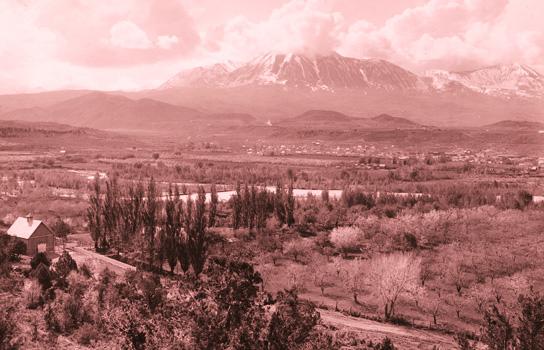By Lydia Hooper
With its extreme climate and rocky landscapes, Colorado might seem a surprising location for wineries. But when British explorer Isabella Bird traversed Colorado’s St. Vrain Canyon by horseback in 1873, she described “wild grape vines [trailing] their lemon-colored foliage along the ground.” Plenty of sunshine and cool nights in Colorado provide the ideal conditions for grapes with the complex character needed to produce delicious wines.
Many European settlers who came to Colorado for mining brought viticulture with them. By the end of the 19th century, Colorado produced nearly one million pounds of grapes annually, primarily from the rich valleys of the Western Slope. These vineyards were uprooted when Prohibition was enacted, four years earlier in Colorado than in the rest of the nation.
Wine production resumed in 1977 when the Colorado General Assembly made way for small farm wineries with the Colorado Limited Winery Act. When the Colorado Wine Industry Development Act passed in 1990, five licensed wineries operated in Colorado; today they number more than 100, and most are still small, family-owned wineries using Colorado-grown grapes.
Colorado has two federally designated American Viticultural Areas (AVA). The West Elks AVA includes Paonia and Hotchkiss. The Grand Valley AVA, which includes Grand Junction and Palisade, was named one of the top ten wine travel destinations in the world by Wine Enthusiast Magazine last year.
To celebrate Colorado’s historic relationship with wine, consider visiting these areas, as well as wineries in other parts of the state. Note: Most wineries are seasonal, so be sure to check availability in advance of your trip. Please designate a driver and/or use provided shuttles to ensure your travels are safe and enjoyable.
Grand Junction and Palisade
Grand Valley is the birthplace of Colorado wine, so if you plan to visit multiple destinations, this serves as a perfect place to start. Governor George A. Crawford, who founded Grand Junction in 1881, first saw the valley’s potential for growing grapes; he planted 60 acres on Rapid Creek near Palisade. In the 1970s a decline in peaches and a surge in federal aid led to the rise of wine production in the area. You can bike or drive the Palisade Fruit & Wine Byway to experience the rich orchards, lavender gardens, farm-fresh fruit stands, and of course wineries. Some of the best and oldest wineries include Colterris at the Overlook, Grande River Vineyards, Colorado Cellars Winery, Plum Creek Cellars, Carlson Vineyards, and Maison la Belle Vie Winery, whose owner brings to Colorado his family’s 150-year history of making wine in France’s Loire Valley. While you’re in the area, also visit Dinosaur National Monument and historic downtown Palisade, which hosts the Colorado Mountain Winefest every September.
Paonia
Paonia is named after the lush peony flower and, like Palisade, the area is known for its abundant fruit orchards. This once-sleepy historic town has grown because of the wine industry. Some claim it is one of the few regions that has successfully cultivated and bottled a Pinot Noir. Wineries to visit include Black Bridge Winery, Azura Cellars, and Stone Cottage Cellars. A trip to Paonia is also a good excuse to visit another of Colorado’s lesser-known gems, the stunning Black Canyon of the Gunnison National Park. Despite the Utes’ many journeys through the area as well as several previous expeditions of Europeans, not until the middle of the nineteenth century—when the American West basked in the nation’s attention—did railroaders and recreationists penetrate the canyon.
Denver-metro area
About one-third of the wineries in Colorado producing premium wines from local grapes lie within a two-hour drive of Denver and Denver International Airport. In 1968, Ivancie Winery opened in Denver, using grapes from around the Grand Valley. The winemaker, Warren Winiarski, went on to become the first winemaker at Robert Mondavi Winery and won the Judgment of Paris competition in 1976. Urban wineries have taken off in recent years, perhaps piggybacking on the boom of craft beer. Check out Denver’s Balistreri Vineyards, which started as a flower farm in 1964, and Boulder’s Redstone Meadery, the largest craft meadery in the nation. If you want to venture farther out of the metro area, other Front Range cities with wineries include Loveland, Boulder, Evergreen, Arvada, Salida, Cascade, and Colorado Springs.
Lydia Hooper is the digital content manager at History Colorado.
AAA Travel and History Colorado have teamed up to offer specially crafted vacations called Curated Adventures. Join Tom “Dr. Colorado” Noel for an extravagant tour of the state’s best wines.
Want to Read More?
The Winelands of Colorado
From the land of the ancient Pueblo and the mysterious ruins of Mesa Verde, through the verdant farmlands of the Grand Valley and on into hip and urban downtown Denver, Colorado’s winemakers are wielding passion and grit – and modern viticultural science – to create wines that are garnering recognition and awards on today’s national and international wine scene.
Exploring Colorado Wineries
A comprehensive guidebook to all of Colorado's 125+ wineries and tasting rooms. It is the first exclusively Colorado guidebook written in a decade. The 272-colorful pages and detailed information connects the reader to each of the state's wineries. Each winery's two-page spread contains contact information, wines produced, tasting room hours, directions and a special message from the owner. The book includes several additional sections.



